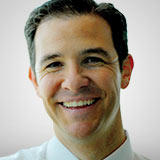Stuart McPhee explains why he uses mostly technical analysis to find great trades.
I’m here with Stuart McPhee. You’re the author of Trading in a Nutshell, loved the book. I gleaned from everything that I get from you that there’s so much conversation out there about fundamentals. We’re all talking about the economic crisis in Europe, the political crisis in Europe, the fiscal cliff in the United States, the supply of oil and those fundamental stories get all the attention. What about the technicals? You’re a technical trader.
Yes.
What do you look at when you look at these charts?
I love the clarity of charts. I love how it perfectly catches the sentiment and the feelings amongst all of the participants, the buyers and the sellers, always demanding and supplying. I love how technical analysis is almost a study of mass psychology.
Right.
We’re able to sit objectively on the sidelines and monitor the way people are responding to news. Whatever unfolds in the markets and all those things you brought up have valid concerns and issues that we’re currently facing, but whatever unfolds we’ll see that perfectly illustrated in the charts and I can very objectively apply my trading rules and execute.
Do you find that for new traders or even experienced traders, that the fundamentals can get in the way and if they can, how does that happen?
Absolutely it can. I think it makes a lot of sense to learn about why things are happening in the market. I personally have moved beyond that and don’t concern myself too much with it, but if you don’t know any better I think it does make a lot of sense. Why is the market doing what it’s doing? I want to k now about that. I want to turn into CNN. I want to listen to CNBC. I want to know the market. My criticism, a little bit, is often commentary talks about why the market did what it did as opposed to what we think it’s going to do. That doesn’t help people make money telling us why the market did what it did. Technical analysis, we can develop high probability, opportunities and look for our rules.
When you’re living on the right edge of the chart, you’re truly concerned with what’s going to happen next and planning for it as opposed to becoming obsessed with the past.
Yes.
How do you structure your charts? You look at short timeframe charts plus longer timeframe charts?
I always start with a daily chart on the foreign exchange. It just provides me with a bigger picture. We were talking earlier, off the air, about the euro and where it’s going. The daily chart provides a great overall picture of what the overall trend is of the euro. Then I narrow it down to my narrower timeframe of four or hourly charts and that’s where I execute and make the trading decisions in accordance with the overall picture and the longer-term trading.
Do you have a desktop set up? I’m thrilled to know how you do it. Do you just work with a laptop? Do you have a bunch of monitors?
No, it’s not elaborate. It’s not like I have 21 monitors sitting up on a wall, which I think some people have visions of that’s what a trader is monitoring different channels and data and the like. No, it’s simply my laptop and a second monitor. It’s all big enough to capture everything there.
I went to Wall Street one time, Stuart, and I met with the head of trading for a prop section for a major bank. He had 16 monitors up. I said what do you see in all these 16 monitors. He said I don’t look at the 16; I just focus on this one.
There you go.
It’s all about focus, isn’t it?
It looks good.



















